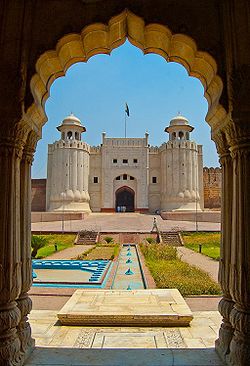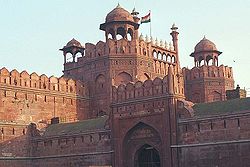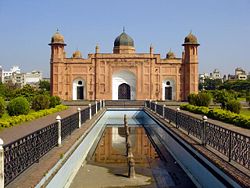The Mughals
The Mughal Empire (Persian: شاهان مغول Shāhān-e Moġul; Urdu: مغلیہ سلطنت; self-designation: گوركانى
- Gūrkānī),
or Mogul Empire in former English usage, was an Indian-Islamic imperial
power that ruled a large portion of the Indian subcontinent which began in
1526, invaded and ruled most of South Asia by the late 17th and early 18th
centuries by forming alliance with Indian Maharaja, and ended in the mid-19th
century. The Mughal Emperors were descendants of the Timurids, and at the
height of their power around 1700, they controlled most of the Indian.
Subcontinent — extending from Bengal in the
east to Balochistan in the west, Kashmir in the north to the Kaveri basin in
the south. Its population at that time has been estimated as between 110 and
130 million, over a territory of over 4 million km2 (1.5 million
square miles).

|
| The Alamgiri Gate is the main entrance to the Lahore Fort. |
The "classic period" of the Empire started in 1556 with the
accession of Jalaluddin Mohammad Akbar, better known as Akbar the Great. It
ended with the death of Emperor Aurangzeb in 1707, although the Empire continued
for another 150
years. During this period, the Empire was marked by a highly centralized
administration connecting the different regions. All the significant monuments
of the Mughals, their most visible legacy, date to this period which was
characterised by the expansion of Persian cultural influence in the Indian
subcontinent, with brilliant literary, artistic and architectural results.
Following 1725 the empire declined rapidly, weakened by wars of succession,
agrarian crises fueling local revolts, the growth of religious intolerance, the
rise of the Maratha, Durrani, and Sikh empires and finally British colonialism.
The last king, Bahadur Zafar Shah II, whose rule was restricted to the city of Delhi,
was imprisoned and exiled by the British after the Indian Rebellion of 1857.
The name Mughal is derived from the original homelands of the
Timurids, the Central Asian steppes once conquered by Genghis Khan and hence
known as Moghulistan, "Land of Mongols". Although early
Mughals spoke the Chagatai language and maintained Turko-Mongol practices, they
were essentially Persianized. They transferred the Persian literature and
culture to India, thus forming the base for the Indo-Persian culture.
Babur learnt about the riches of 'Hindustan' and conquest of
it by his ancestor, Timur Lang in 1503 at Dikh-Kat a place in Tansoxiana
region. At that time, he was roaming as a wanderer after losing his
principality Farghana. In his memoirs he wrote that after he had acquired
Kabul, (in 1514), he desired to regain the territories in Hindustan held once
by Turks. He started his exploratory raids from September 1519 when he visited
the Indo-Afghan borders to suppress the rising by Yusufzai tribes. He undertook
similar raids up to 1524 and had established his base camp at Peshawar.
In 1526, Babur defeated the last of the Delhi Sultans, Ibrahim Shah Lodi, at
the First Battle of Panipat. To secure his newly founded kingdom, Babur then
had to face the formidable Rajput Rana Sanga of Chittor, at the Battle of
Khanwa. Rana Sanga offered stiff resistance but was defeated due to treachery
within his own ranks.
Babur's son Humayun succeeded him in 1530, but suffered reversals at the
hands of the Pashtun Sher Shah Suri and lost most of the fledgling empire
before it could grow beyond a minor regional state. From 1540 Humayun became
ruler in exile, reaching the court of the Safavid rule in 1554 while his force
still controlled some fortresses and small regions. But when the Pashtuns fell
into disarray with the death of Sher Shah Suri, Humayun returned with a mixed
army, raised more troops and managed to reconquer Delhi in 1555.
Humayun crossed the rough terrain of the Makran with his wife. The resurgent
Humayun then conquered the central plateau around Delhi, but months later died
in an accident, leaving the realm unsettled and in war.
Akbar succeeded his father on 14 February 1556, while in the midst of a war
against Sikandar Shah Suri for the throne of Delhi. He soon won his eighteenth
victory at age 21 or 22. He became known as Akbar, as he was a wise
ruler, set fair but high taxes. He was born in a Hindu Rajput household. He was
a more inclusive in his approach to the non-Muslim subjects of the Empire. He
investigated the production in a certain area and taxed inhabitants one-fifth
of their agricultural produce. He also set up an efficient bureaucracy and was
tolerant of religious differences which softened the resistance by the locals.
He made alliances with Rajputs and appointed Hindu generals and administrators.
Later in life, he devised his own brand of religion based on tolerance, and
inspired by viewpoints of Hinduism and Islam. After his death, this religion
did not become popular, but is still remembered for its noble intentions of
bringing people and minds together.

|
| The Red Fort in Delhi was the main palace of the empire. |
Jahangir, son of Emperor Akbar, ruled the empire from
1605–1627. In October 1627, Shah Jahan, son of Emperor Jahangir succeeded to
the throne, where he inherited a vast and rich empire. At mid-century this was
perhaps the greatest empire in the world. Shah Jahan commissioned the famous Taj
Mahal (1630–1653) in Agra which was built by the Persian architect Ustad Ahmad
Lahauri as a tomb for Shah Jahan's wife Mumtaz Mahal, who died giving birth to
their 14th child. By 1700 the empire reached its peak under the leadership of Aurangzeb
Alamgir with major parts of present day India, Pakistan and most of Afghanistan
under its domain. Aurangzeb was the last of what are now referred to as the
Great Mughal kings, living a shrewd life but dying peacefully.
The Mughal Empire was the dominant power in the Indian subcontinent between
the mid-16th century and the early 18th century. Founded in 1526, it officially
survived until 1858, when it was supplanted by the British Raj. The dynasty is
sometimes referred to as the Timurid dynasty as Babur was descended from Timur.
The Mughal dynasty was founded when Babur, hailing from Ferghana (Modern Uzbekistan),
invaded parts of northern India and defeated Ibrahim Shah Lodhi, the ruler of
Delhi, at the First Battle of Panipat in 1526. The Mughal Empire superseded the
Delhi Sultanate as rulers of northern India. In time, the state thus founded by
Babur far exceeded the bounds of the Delhi Sultanate, eventually encompassing a
major portion of India and earning the appellation of Empire. A brief
interregnum (1540–1555) during the reign of Babur's son, Humayun, saw the rise
of the Afghan Suri Dynasty under Sher Shah Suri, a competent and efficient
ruler in his own right and Hindu king Hem Chandra Vikramaditya, also called Hemu.
However, Sher Shah's untimely death and the military incompetence of his
successors enabled Humayun to regain his throne in 1555. However, Humayun died
a few months later, and was succeeded by his son, the 13-year-old Akbar the
Great.
The greatest portions of Mughal expansion was accomplished
during the reign of Akbar (1556–1605). The empire was maintained as the
dominant force of the present-day Indian subcontinent for a hundred years
further by his successors Jahangir, Shah Jahan, and Aurangzeb. The first six
emperors, who enjoyed power both ‘’de jure’’ and ‘’de facto’’, are usually
referred to by just one name, a title adopted upon his accession by each
Emperor. The relevant title is bolded in the list below.

|
| Lalbagh Fort, constructed in the mid 17th century in Dhaka. |
Akbar the Great initiated certain important policies, such
as religious liberalism (abolition of the jizya tax), inclusion of Hindus in
the affairs of the empire, and political alliance/marriage with the Hindu Rajput
caste, that were innovative for his milieu; he also adopted some policies of
Sher Shah Suri, such as the division of the empire into sarkar Rajs, in his
administration of the empire. These policies, which undoubtedly served to
maintain the power and stability of the empire, as the Hindu populace had shown
resistance to the Islamic conquest in its years in the Indian subcontinent.
These were preserved by his two immediate successors but were discarded by
Aurangzeb, who followed a more strict interpretation of Islam and followed a
stricter policy of intolerance to the practice of religions than his own.
Furthermore, Aurangzeb spent nearly his entire career seeking to expand his
realm into the Deccan and south India, Assam in the east; this venture sapped
the resources of the empire while provoking strong resistance from the Marathas,
Rajputs, Sikhs of Punjab, Ahoms of Assam. Ahoms in Assam successfully resisted
the Mughal invasions, the last battle being the Battle of Saraighat. It is
interesting to note in this regard that while the Mughals ruled India for a
nearly three hundred years they never ruled the complete geographical extent of
the Indian subcontinent. The power was mostly centered around Delhi which was
for historical reasons considered a strategic stronghold but there always
existed strong independent Hindu kingdoms which maintained their sovereignty
and offered stiff resistance to Mughal expansion.
After the emperor Aurangzeb's death in 1707, the empire fell
into decline. Beginning with Bahadur Shah I, the Mughal Emperors progressively
declined in power and became figureheads, being initially controlled by sundry
courtiers and later by various rising warlords. In the 18th century, the Empire
suffered the depredations of invaders like Nadir Shah of Persia and Ahmed Shah
Abdali of Afghanistan, who repeatedly sacked Delhi, the Mughal capital. The
greater portion of the empire's territories in India passed to the Marathas,
who sacked Delhi, reducing the once powerful and mighty empire to just lone
city before falling to the British. Other adversaries included Sikh Empire and Hyderabad
Nizams. In 1804, the blind and powerless Shah Alam II formally accepted the
protection of the British East India Company. The British had already begun to
refer to the weakened Emperor as "King of Delhi," rather than
"Emperor of India." The once glorious and mighty Mughal army was
disbanded in 1805 by the British; only the guards of the Red Fort were spared
to serve with the King Of Delhi, which avoided the uncomfortable implication
that British sovereignty was outranked by the Indian monarch.
Nonetheless, for a few decades afterward, the BEIC continued to rule the
areas under its control as the nominal servants of the emperor, and in his
name. In 1857, even these courtesies were disposed. After some rebels in the Sepoy
Rebellion declared their allegiance to Shah Alam's descendant, Bahadur Shah
Zafar (mostly symbolically, as he was just a figurehead for the purpose of
rebellion), the British decided to abolish the institution altogether. They
deposed the last Mughal Emperor in 1857 and exiled him to Burma, where he died
in 1862. Thus the Mughal dynasty came to an end, which formed a momentous
chapter in the history of India.
There are still many Mughals living in the Indian Subcontinent. The term
Mughal in the current socio-political context also does not have decisive
meaning as the blood lines of the original Mughals are now mixed with the local
population and have South-Asian identities which are stronger than any original
Turkic or Mongoloid origins.
|
 |
|
|
 |
|
|
 |
|
|
|

